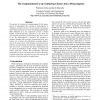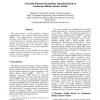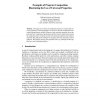IPPS
1999
IEEE
14 years 11 months ago
1999
IEEE
This paper describes a United States Air Force Advanced Technology Demonstration (ATD) that applied value-based scheduling to produce an adaptive, distributed tracking component ap...
IPPS
1999
IEEE
14 years 11 months ago
1999
IEEE
We explore the creation of a metacomputer by the aggregation of independent sites. Joining a metacomputer is voluntary, and hence it has to be an endeavor that mutually benefits a...
IPPS
1999
IEEE
14 years 11 months ago
1999
IEEE
Parallel and distributed systems are representative of large and complex systems that require the application of formal methods. These systems are often unreliable because implemen...
IPPS
1999
IEEE
14 years 11 months ago
1999
IEEE
This paper presents a parallel phoneme recognition algorithm based on the continuous Hidden Markov Model (HMM). The parallel phoneme recognition algorithm distributes 3-state HMMs...
IPPS
1999
IEEE
14 years 11 months ago
1999
IEEE
In this paper, we present ParaPART, a parallel version of a mesh partitioning tool, called PART, for distributed systems. PART takes into consideration the heterogeneities in proce...
IPPS
1999
IEEE
14 years 11 months ago
1999
IEEE
We present our experience of building a prototype system based on the Utility Model for adaptive multimedia. The Utility Model is proposed to capture the issues and dynamics in mul...
IPPS
1999
IEEE
14 years 11 months ago
1999
IEEE
We present a new arrangement of directory bits called the segment directory to improve directory storage efficiency: a segment directory can point to several sharing processors wi...
IPPS
1999
IEEE
14 years 11 months ago
1999
IEEE
Clustering and scheduling of tasks for parallel implementation is a well researched problem. Several techniques have been presented in the literature to improve performance and re...
IPPS
1999
IEEE
14 years 11 months ago
1999
IEEE
The diversity of computers and networks within a distributed system makes these systems highly heterogeneous. System heterogeneity complicates the design of static applications tha...
IPPS
1999
IEEE
14 years 11 months ago
1999
IEEE
Abstract. This paper uses a theory of composition based on existential and universal properties. Universal properties are useful to describe components interactions through shared ...



